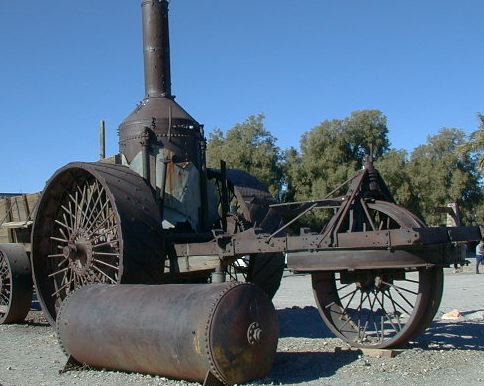 It's
New Year's Day, 1999 and I'm sitting in my trailer in Death Valley
National Park. I just took this set of pictures of a steam tractor
that was used for a short while to haul borax over terrible roads
in equally terrible desert heat. This is just a relic now, but in
its day, it must have made an awesome sight chugging across the
desert.
It's
New Year's Day, 1999 and I'm sitting in my trailer in Death Valley
National Park. I just took this set of pictures of a steam tractor
that was used for a short while to haul borax over terrible roads
in equally terrible desert heat. This is just a relic now, but in
its day, it must have made an awesome sight chugging across the
desert.
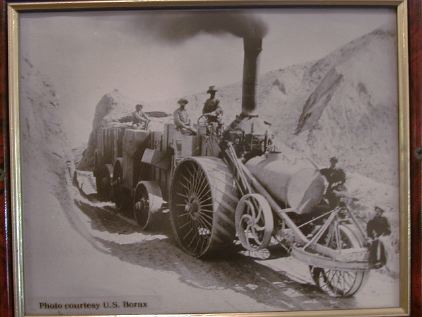 I found this old photo of Old Dinah at the
Borax Museum at the Furnace Creek Ranch in Death Valley. It
actually did run but it would appear that it was not overly
successful.
I found this old photo of Old Dinah at the
Borax Museum at the Furnace Creek Ranch in Death Valley. It
actually did run but it would appear that it was not overly
successful.
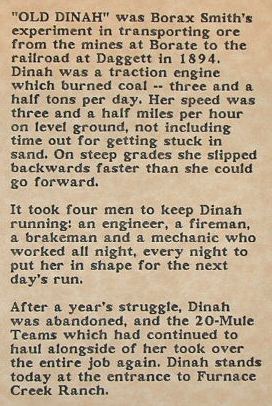 This placard accompanied the photo above and
provides a short summary of history of Old Dinah. This mechanical
marvel was purchased in 1894 and it was intended to replace the
20-Mule Teams that hauled borax from the Borate to Daggett. Old
Dinah required constant maintenance and had major problems with
sand and steep grades. After a one year trial, mules proved more
productive and reliable, but they too, were replace later by a
narrow gauge railroad in 1898.
This placard accompanied the photo above and
provides a short summary of history of Old Dinah. This mechanical
marvel was purchased in 1894 and it was intended to replace the
20-Mule Teams that hauled borax from the Borate to Daggett. Old
Dinah required constant maintenance and had major problems with
sand and steep grades. After a one year trial, mules proved more
productive and reliable, but they too, were replace later by a
narrow gauge railroad in 1898.
Old Dinah got one more chance when borax operations resumed in Death Valley in 1904. Trying to avoid the expense of a railroad into Death Valley, the Borax Company graded a 98 mile tractor road from the borax mines to the railroad. Dinah broke down on her first trip, and hand to be towed home by the very mules she had tried so long to replace. In 1910, Old Dinah was sold to a freighter for use hauling supplies between Beatty and the Keane Wonder Mine. After a couple of years, Dinah broke down in the Daylight Pass and her owner abandoned her in disgust. In 1932, Harry Gower rescued Old Dinah and brought her to her present location at the Furnace Creek Ranch.
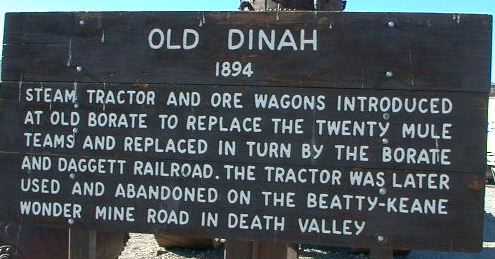 Most of what I know about the history of this
tractor is on the sign provided by the Park Service, a couple of
comments about it that I found in the Visitor Center bookstore and
the displays at the Furnace Creek Ranch Borax Museum. This tractor
was such an attractive display, that I took an inordinate number of
pictures. Old Dinah is currently on display in front of the Furnace
Creek Ranch in Death Valley National Park.
Most of what I know about the history of this
tractor is on the sign provided by the Park Service, a couple of
comments about it that I found in the Visitor Center bookstore and
the displays at the Furnace Creek Ranch Borax Museum. This tractor
was such an attractive display, that I took an inordinate number of
pictures. Old Dinah is currently on display in front of the Furnace
Creek Ranch in Death Valley National Park.
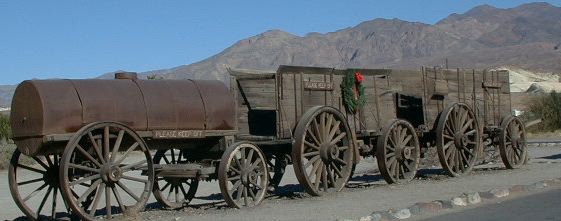 Dinah was built to replace the famous 20 Mule Teams
(actually 18 mules and 2 horses) that had been used to haul borax
out of the salt flats of Death Valley. It took the team 10 days one
way to haul 24 tons of borax (a valuable mineral used in glass,
soaps, fluxes and glues) from Death Valley to the railhead 165
miles distant.
Dinah was built to replace the famous 20 Mule Teams
(actually 18 mules and 2 horses) that had been used to haul borax
out of the salt flats of Death Valley. It took the team 10 days one
way to haul 24 tons of borax (a valuable mineral used in glass,
soaps, fluxes and glues) from Death Valley to the railhead 165
miles distant.
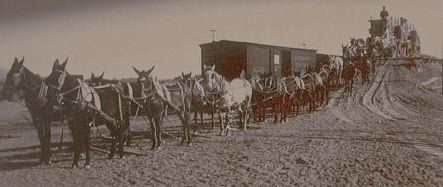 Just as an aside, this is the true meaning of the term
"team track." A team was literally drawn up beside a train for
loading or unloading. Here a load of 24 tons of nearly pure borax
is being loaded onto the AT&SF.
Just as an aside, this is the true meaning of the term
"team track." A team was literally drawn up beside a train for
loading or unloading. Here a load of 24 tons of nearly pure borax
is being loaded onto the AT&SF.
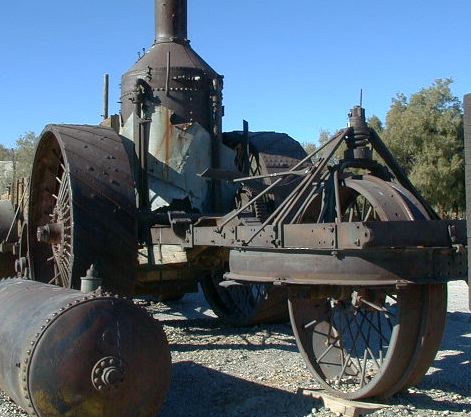 Old Dinah was a tricycle type steam tractor with a upright boiler
and gear drive. From the wear patterns on the ridged front and
cleated rear wheels, the wheels were run as they are, steel rims
against hard dirt. Old Dinah was not a real speedster at 3,5 mph at
best, but faster than mules. Old Dinah had no sign of having any
brakes at all. From information I found in a book on borax mining,
Old Dinah burned oil, however I didn't find any sign of an oil
tank. Also, the placard in the museum indicated that it burned
coal. The tank on the ground was probably its water supply. There
is a saddle above the frame that clearly held the tank and there
was a photo in a book showing the tank in that location. Old Dinah
must have been hard to feed, as whatever water was available in
this desert has large quantities of dissolved salts, the worst up
to 6%.
Old Dinah was a tricycle type steam tractor with a upright boiler
and gear drive. From the wear patterns on the ridged front and
cleated rear wheels, the wheels were run as they are, steel rims
against hard dirt. Old Dinah was not a real speedster at 3,5 mph at
best, but faster than mules. Old Dinah had no sign of having any
brakes at all. From information I found in a book on borax mining,
Old Dinah burned oil, however I didn't find any sign of an oil
tank. Also, the placard in the museum indicated that it burned
coal. The tank on the ground was probably its water supply. There
is a saddle above the frame that clearly held the tank and there
was a photo in a book showing the tank in that location. Old Dinah
must have been hard to feed, as whatever water was available in
this desert has large quantities of dissolved salts, the worst up
to 6%.
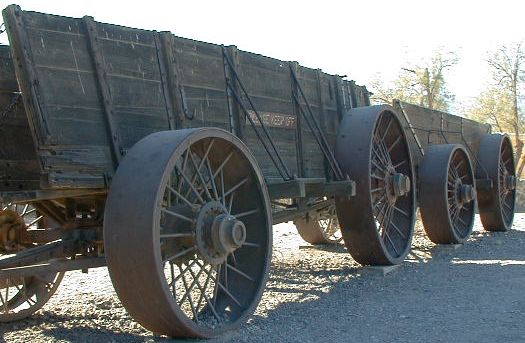 Old Dinah was claimed to be unsuccessful even though
it could haul much more borax in a load than the mules. Compare the
size of these wagons to the ones on the 20 mule team above. I
estimate that the load was probably 3 times that of the mule drawn
wagons (hence the steel wheels) and it probably made the trip in
about half the time. However, the reference books indicated that it
had a tendency to sink into soft dirt (requiring the mule teams to
pull it out) and it tended to rear up on steep grades.
Old Dinah was claimed to be unsuccessful even though
it could haul much more borax in a load than the mules. Compare the
size of these wagons to the ones on the 20 mule team above. I
estimate that the load was probably 3 times that of the mule drawn
wagons (hence the steel wheels) and it probably made the trip in
about half the time. However, the reference books indicated that it
had a tendency to sink into soft dirt (requiring the mule teams to
pull it out) and it tended to rear up on steep grades.
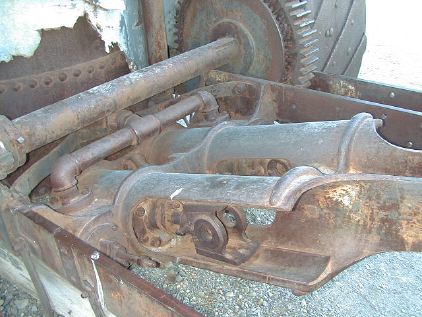 Old Dinah was powered by two cylinders situated
between the frame members just forward of the boiler. Part of the
mechanism is gone, but the crossheads were apparently connected to
a crank shaft that was held in the remaining bearings. The
cylinders were fed with piston valves, a little unusual for an
machine built before the turn of the century.
Old Dinah was powered by two cylinders situated
between the frame members just forward of the boiler. Part of the
mechanism is gone, but the crossheads were apparently connected to
a crank shaft that was held in the remaining bearings. The
cylinders were fed with piston valves, a little unusual for an
machine built before the turn of the century.
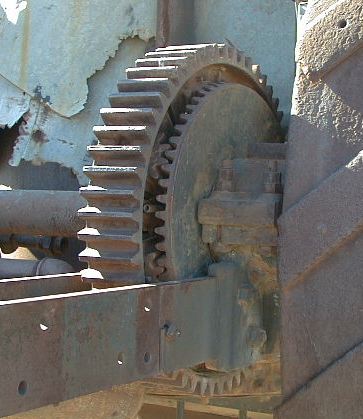 The missing shaft was connected to this
large gear probably by a short gear train that fit within the
double frame rails on that side. Inside this main gear are smaller
differential gears that transferred torque to the wheel drive
gears.
The missing shaft was connected to this
large gear probably by a short gear train that fit within the
double frame rails on that side. Inside this main gear are smaller
differential gears that transferred torque to the wheel drive
gears.
 The wheel drive gears engaged a circular rack
inside the drive wheel. When Old Dinah was moving forward, the dirt
and rocks that fell into the rack would drop out before they got to
the drive gear. I imagine that this gear was run mostly dry so that
it would not collect crud.
The wheel drive gears engaged a circular rack
inside the drive wheel. When Old Dinah was moving forward, the dirt
and rocks that fell into the rack would drop out before they got to
the drive gear. I imagine that this gear was run mostly dry so that
it would not collect crud.
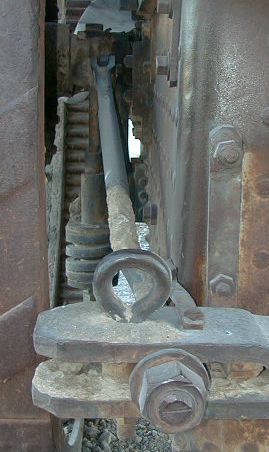 Old Dinah transferred its tractive effort from the main
wheel shaft to the drawhead at the back of the tractor through bars
bolted to the axle assembly and the drawhead.
Old Dinah transferred its tractive effort from the main
wheel shaft to the drawhead at the back of the tractor through bars
bolted to the axle assembly and the drawhead.
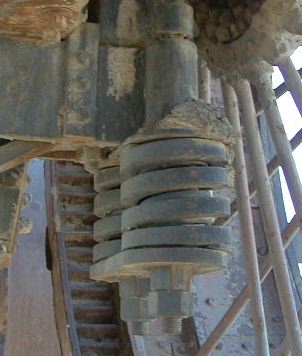 Old Dinah had a sprung suspension of shorts. Two coil
springs under the tractor on each side supported the weight of the
tractor and a third spring was on top of the front wheel assembly.
Even so, it appears that its suspension travel was severely
limited, probably not more than 2" total. It must have been a
pretty harsh ride.
Old Dinah had a sprung suspension of shorts. Two coil
springs under the tractor on each side supported the weight of the
tractor and a third spring was on top of the front wheel assembly.
Even so, it appears that its suspension travel was severely
limited, probably not more than 2" total. It must have been a
pretty harsh ride.
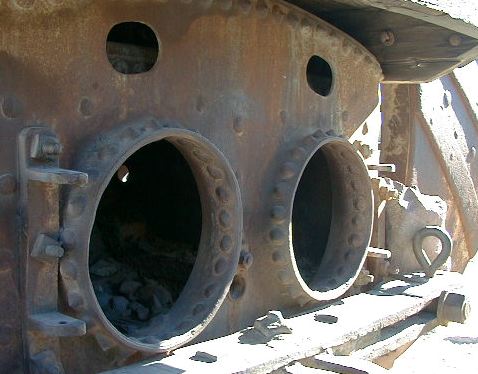 Old Dinah's firebox was small. I didn't see any signs of
an oil burner in the firebox. Since the cylinders were quite small
and the tractor's speed was probably quite low, the small firebox
probably still allowed the boiler to make enough steam.
Old Dinah's firebox was small. I didn't see any signs of
an oil burner in the firebox. Since the cylinders were quite small
and the tractor's speed was probably quite low, the small firebox
probably still allowed the boiler to make enough steam.
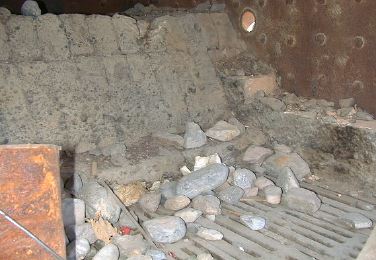 The grate was pretty small, but it looks like a coal grate. It
wouldn't need grate shakers as all of the grate could be easily
reached to be cleaned of clinkers.
The grate was pretty small, but it looks like a coal grate. It
wouldn't need grate shakers as all of the grate could be easily
reached to be cleaned of clinkers.